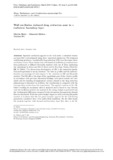JavaScript is disabled for your browser. Some features of this site may not work without it.
| dc.contributor.author | Skote, Martin | |
| dc.contributor.author | Mishra, Maneesh | |
| dc.contributor.author | Wu, Yanhua | |
| dc.date.accessioned | 2018-12-11T11:43:45Z | |
| dc.date.available | 2018-12-11T11:43:45Z | |
| dc.date.issued | 2018-08-30 | |
| dc.identifier.citation | Martin Skote, Maneesh Mishra and Yanhua Wu. Wall oscillation induced drag reduction zone in a turbulent boundary layer. Flow, Turbulence and Combustion, March 2019, Volume 102, Issue 3, pp 641-666 | en_UK |
| dc.identifier.issn | 1386-6184 | |
| dc.identifier.uri | https://doi.org/10.1007/s10494-018-9979-2 | |
| dc.identifier.uri | https://dspace.lib.cranfield.ac.uk/handle/1826/13717 | |
| dc.description.abstract | Spanwise oscillation applied on the wall under a turbulent boundary layer flow is investigated using direct numerical simulation. The temporal wall-forcing produces a considerable drag reduction (DR) over the region where oscillation occurs. Three simulations with identical oscillation parameters have been performed at different Reynolds numbers with one of them replicating the experiment by Ricco and Wu (Exp. Therm. Fluid Sci. 29, 41–52, 2004). The downstream development of DR in the numerical simulation and experiment is nearly identical. The velocity profiles and the indicator function are investigated with respect to the variation in DR and Reynolds number. The DR affects the slope of the logarithmic part of the velocity profile in accordance with previous theoretical findings. Low speed streaks are visualized and the bending of longitudinal vortices related to the drag reduction phenomenon is discussed. In addition, the visualization is compared with the corresponding results from the experiments. The spatial transient of the DR before reaching its maximum value is analyzed and is found to vary linearly with the oscillation period. An analysis of the energy budget is presented and the fundamental differences compared to the streamwise homogeneous channel flow are elucidated. While the power budget improves with increasing Reynolds number, it is shown that the net power remains negative for the wall forcing parameters considered here, even under ideal conditions. On the other hand, the analysis together with channel and boundary layer flow data in the literature provides an estimation of net energy saving for boundary layer flows which depends on the streamwise extent of the oscillating zone. | en_UK |
| dc.language.iso | en | en_UK |
| dc.publisher | Springer | en_UK |
| dc.rights | Attribution-NonCommercial 4.0 International | * |
| dc.rights.uri | http://creativecommons.org/licenses/by-nc/4.0/ | * |
| dc.subject | Turbulent boundary layer | en_UK |
| dc.subject | Drag reduction | en_UK |
| dc.subject | DNS | en_UK |
| dc.subject | Wall oscillation | en_UK |
| dc.title | Wall oscillation induced drag reduction zone in a turbulent boundary layer | en_UK |
| dc.type | Article | en_UK |
Files in this item
The following license files are associated with this item:
This item appears in the following Collection(s)
-
Staff publications (SATM) [4365]

